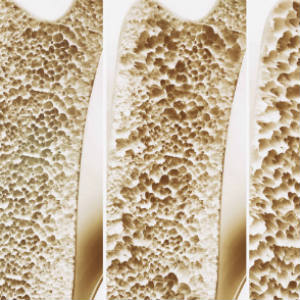When you think of bones, you probably think of incredibly strong material that supports you–and you’d be right. But, the inside of a bone is filled with numerous tiny holes, “like a honeycomb.” This bone tissue naturally breaks down and is built back up regularly. But, as we age, we start to lose more tissue, overall, when compared to what we build. Plus, the holes get bigger, bone gets spongier and the outer layer thins.
This is a natural process but, if this bone density loss goes too far, this condition is known as osteoporosis. More than ten million people in the United States have osteoporosis, which means they are more vulnerable to broken bones. Women are the most vulnerable, because of estrogen levels dropping after menopause, so this condition is therefore more common in women. Women aged 65 and up should be screened for osteoporosis, with at-risk women starting at a younger age. A score of -2.5 or lower leads to a diagnosis of osteoporosis and, therefore, an increased risk for fractures. Men, meanwhile, should talk to their doctors about this condition and ask about screening recommendations.
Risk Factors for Developing Osteoporosis
A key risk factor is poor nutrition, according to HealthInAging.org, especially when it’s poor enough for protein-calorie malnutrition (PCM) to develop. PCM occurs in one out of every four older people. Why? Here are scenarios; the person:
- lives alone and eats poorly
- was in the hospital for a lengthy amount of time
- has a chronic disease and/or takes medication that leads to appetite loss
- struggles to eat enough because of dental problems
No matter the cause, poor nutrition typically causes calcium shortage. When you don’t take in enough calcium, your body takes what it needs from your bones. And, the reality is that you can suffer from PCM even if you haven’t lost weight.
Your ethnic/cultural background may play a role, with white populations and people of Asian descent having reasonably high rates of risk. On the other hand, African Americans, Hispanics and Native Americans have a lower risk. Reasons might be genetic, or they might relate to diet and/or different levels of physical activities, or a combination of these risk factors.
Additional risk factors listed by the National Institute of Health include body size, with small, thin women at a greater one, and family history. As you can see, some risk factors for developing osteoporosis are under your control and others are not. So, it’s important to take full advantage of the ones that are under your control.
Preventing Osteoporosis
Eating a healthy diet is crucial. Avoid smoking and limit alcohol use. Exercise helps people, even older adults, to maintain a healthy bone mass. And, the National Osteoporosis Association lists two types of exercises that are important for building/maintaining density in bones:
- Weight-bearing exercises that cause you to move against gravity while upright, which are sub-divided into:
- High-impact: dancing, hiking, jogging, stair climbing and so forth
- Low-impact: fast walking, low-impact aerobics, stair-step machines and so forth
- Muscle-strengthening exercises, which include weight-lifting, weight machines, rising on your toes while standing and so forth
People with osteoporosis who have broken a bone or are at risk of doing so may need to avoid high-impact exercises. If you fall into that category, talk to your doctor before exercising.
We recommend you read the entire article for more information. And, another publication by the National Osteoporosis Association provides guidance in getting enough calcium in your diet, as well as vitamin D, which also helps in preventing osteoporosis.
Vitamin D is found in:
- Wild-caught fatty fish, including mackerel, salmon and tuna
- Fortified milk/dairy products
- Fortified orange juice
- Fortified cereal
Calcium is found in oranges, collard greens, salmon, yogurt, milk and cheese, fortified foods and more.
Take full advantage of strategies to prevent this condition and, if diagnosed, work with your doctor to manage it as effectively as possible.











